We have a brief history of Graham Bros, Dodge Bros, Dodge, and Ram trucks after these articles...
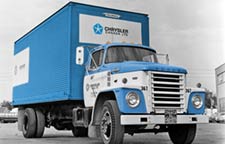 The often-confusing Dodge truck body codes
The often-confusing Dodge truck body codes
With select Jeeps and Rams
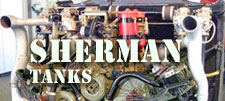 Chrysler: making Grant, Lee, and Sherman Tanks
Chrysler: making Grant, Lee, and Sherman Tanks
(and the big Multibank engines)
 How Ram was born of Avard Fairbanks and Dodge
How Ram was born of Avard Fairbanks and Dodge
One of the very few marques to be named after its own ornaments, and how that came to pass
 Ram ProMaster Commercial Van
Ram ProMaster Commercial Van
Following the only large front-drive commercial van from 2014 to the present
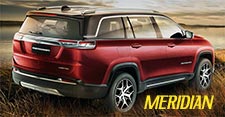 Meridian: Lux Compass with Three Rows
Meridian: Lux Compass with Three Rows
Sorry, it’s only in India so far
 Dodge Hornet: hot compact crossovers
Dodge Hornet: hot compact crossovers
Quick AWD turbo cars, with and without electric motors
 2025 Ram 1500 REV: Ram’s First Electric Pickup Truck
2025 Ram 1500 REV: Ram’s First Electric Pickup Truck
All the info, all the pics of the first electric pickup to tow 14,000 pounds
 2025 Ram 1500 Ramcharger: Range-Extended Electric Pickup Truck
2025 Ram 1500 Ramcharger: Range-Extended Electric Pickup Truck
692 mile range, 14,000 pounds towing, 4.4 quarters: inside the unique 2025 Ramchargers
 2025 Ram 1500: Powerful Pickup Trucks Without V8s
2025 Ram 1500: Powerful Pickup Trucks Without V8s
Inside the 2025 Ram 1500 series, from the simple V6 to the 510-hp “SST”
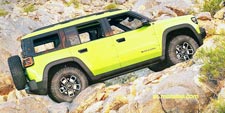 Jeep Recon (BEV)
Jeep Recon (BEV)
Independent suspension, removable doors, battery power: a Jeep that may appeal to less hard-core Wrangler buyers
 2025 Ram ProMaster EV: Battery Power at Last
2025 Ram ProMaster EV: Battery Power at Last
A unique commercial van for North America, with a huge interior, electric motors, and familiar power ratings and forms
 2025 Jeep Wagoneer S: Luxurious battery-electric car
2025 Jeep Wagoneer S: Luxurious battery-electric car
The upcoming battery-electric luxury Jeep
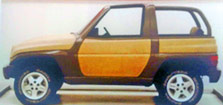 Jeep J90 and JJ
Jeep J90 and JJ
Compact third-world-targeted Jeeps
 Renegade: Fiat-based Jeeps
Renegade: Fiat-based Jeeps
Oddly capable little crossovers
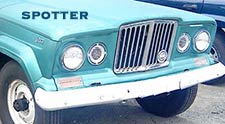 Car Spotter: 1964 Jeep Gladiator Pickup
Car Spotter: 1964 Jeep Gladiator Pickup
Slow sales in 1964, highly collectible today
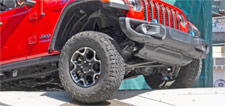 Jeep “death wobble”
Jeep “death wobble”
Causes and fixes of Wrangler-Gladiator steering problems
 Jeep Recon (BEV)
Jeep Recon (BEV)
Independent suspension, removable doors, battery power: a Jeep that may appeal to less hard-core Wrangler buyers
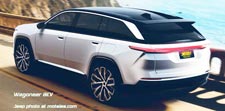 2025 Jeep Wagoneer S: Comfortably, roomy, luxurious battery-electric car
2025 Jeep Wagoneer S: Comfortably, roomy, luxurious battery-electric car
The upcoming battery-electric luxury Jeep
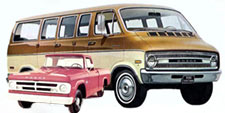 1971 Dodge trucks and vans
1971 Dodge trucks and vans
A surprisingly full range
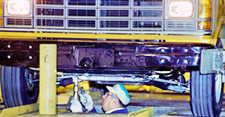 Making Mopar Vans in Windsor
Making Mopar Vans in Windsor
Dodge B-van factory photos
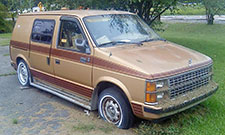 Car Spotter: Custom Ram Van Minivan
Car Spotter: Custom Ram Van Minivan
Customized K Cargo-van Camper
 Ram ProMaster Commercial Van
Ram ProMaster Commercial Van
Following the only large front-drive commercial van from 2014 to the present
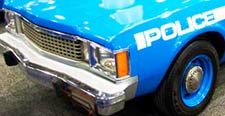 Mopar police cars of 1980: St. Regis/Gran Fury, Aspen/Volare, B-Van
Mopar police cars of 1980: St. Regis/Gran Fury, Aspen/Volare, B-Van
The last of the big Plymouth and Dodge police cars, in their penultimate year, with the final F-body squads
 2025 Ram ProMaster EV: Battery Power at Last
2025 Ram ProMaster EV: Battery Power at Last
A unique commercial van for North America, with a huge interior, electric motors, and familiar power ratings and forms
 Dodge ZD: the Jeep-Based SUV That Never Was
Dodge ZD: the Jeep-Based SUV That Never Was
Could the Grand Cherokee survive a twin?
 Dodge Nitro
Dodge Nitro
the ill-fated Liberty-based SUV
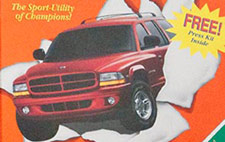 Original Dodge Durango, 1998-2003
Original Dodge Durango, 1998-2003
Successful heavy-hauler three-row SUV
 2009-2020 Dodge Journey: Budget crossover replacing the Caravan
2009-2020 Dodge Journey: Budget crossover replacing the Caravan
Following the crossover from its promising launch to its lingering end
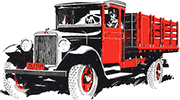 Graham Brothers: the original “Dodge trucks” (and some very, very nice supercharged cars!)
Graham Brothers: the original “Dodge trucks” (and some very, very nice supercharged cars!)
A story of two sets of brothers
 Driving a three-on-the-tree 1977-ish Dodge pickup
Driving a three-on-the-tree 1977-ish Dodge pickup
Tom’s first time with a three-on-the-tree: Carrying a loaded 1970s slant-six Dodge pickup
 Dodge Dude: An Odd Name and Campaign for a Fully Capable Pickup Truck
Dodge Dude: An Odd Name and Campaign for a Fully Capable Pickup Truck
The 1971 Sweptline pickup and its Don Knotts-led ad campaign
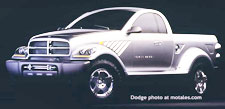 1999 Power Wagon concept car: Extreme looks, big diesel
1999 Power Wagon concept car: Extreme looks, big diesel
The first hint of a new Power Wagon tested a lot of styling and whether people believed in Clean Diesel...
 1996 Dodge Dakota vs Ford Ranger and Chevrolet S-10
1996 Dodge Dakota vs Ford Ranger and Chevrolet S-10
Driving and comparing the Chevy S-10 and Ford Ranger with the Dodge Dakota
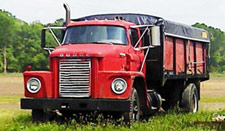 Car Spotter: circa-1970 Dodge C-series medium duty truck
Car Spotter: circa-1970 Dodge C-series medium duty truck
They were pretty popular in their day
 Car Spotter: C-100 California Pickup
Car Spotter: C-100 California Pickup
A clean daily driver classic
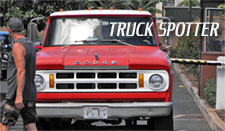 Car Spotter: Dodge D-200 Power Wagon
Car Spotter: Dodge D-200 Power Wagon
As told by Sam Spade, because why not?
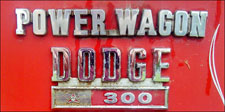 1970-71 Dodge W300 Power Wagon
1970-71 Dodge W300 Power Wagon
Car Spotter #26
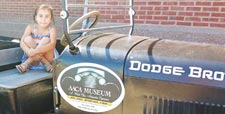 Dodge Brothers Truck for Kids: Car Spotter #27
Dodge Brothers Truck for Kids: Car Spotter #27
Building a Dodge Brothers truck out of spare parts, to get kids interested in The Hobby
While Horace and John Dodge were alive, Dodge Brothers didn’t make trucks—save for one Army model; they sold their chassis to truck makers instead. The brothers died in 1923; their company agreed to provide chassis to Graham Brothers, which made trucks to be sold at Dodge Bros. dealerships. Then, over 1925-26, Dodge Brothers bought the Graham outfit and made their own trucks instead, under their own name. Chrysler bought Dodge Brothers in 1928, making their own six-cylinder engines optional but otherwise keeping the trucks about the same.
Oddly, Chrysler also crated a new line of trucks based on the Plymouth cars in 1928; Fargo trucks lasted until 1930 in the United States, and in export markets, continued past then, as rebadged Dodges.
The first truly purpose-built Dodge trucks came out in 1933, with a car six-cylinder; they gained four wheel drive in 1934 and half-ton versions in 1936, the latter using modern truck frames. Three-quarter-ton and one-ton capacities showed up in 1937. All the trucks were redesigned for 1939; the bodies got modern streamlined styling, and “Job Rated” setups varied equipment to match specific users. Mack and Chrysler were the only American car companies to use their own diesels before World War II.
Production stopped in 1942 for the war; during that time, Chrysler built a massive new plant in Warren for military orders. When civilian production resumed in 1946, they could produce massive quantities of pickups in Warren. Most of these were based on the old 1942 models, but the Power Wagon, an extra-heavy-duty 4x4 created for military use, also joined the lineup.
The 1948 Dodge “B-series” pickups had “pilot house” styling—the cab had bigger glass areas and taller seats to improve visibility, while new steering gear tightened the turning radius. Payload was increased by shifting weight to the front axle. They were popular for trucks in that car-focused era.
The next redesign, the 1954 “C-series,” brought lower cabs and curved single-piece windshields, keeping the wheelbase choices of 108 and 116 inches. Gauges, controls, and even the glove compartment were oriented to the driver. Midyear, Dodge added its efficient but expensive-to-build Hemi engines as options; the largest of these was the 331, with 172 bhp and 220 lb-ft torque. The next year brought a two-speed automatic transmission and optional overdrive on the manual three-speed transmissions on half-ton pickups.
Car ideas came to trucks with fashionable hooded headlights, Sweptline beds (including fins), and two-toned color schemes on the 1957s. They also had optional power steering and power brakes, tubeless tires, a push-button three-speed “LoadFlite” automatic option, and a 12-volt electrical system; all of these were new to Dodge pickups. Buyers could choose between nine engines with twelve rated outputs. Model names were the letter D (rear drive) or W (4x4), followed by a number to show the capacity, and then two zeros—e.g. W300 for a one-ton 4x4—up to the D700 cab-over tractor. Through all this the Power Wagon continued, mainly unchanged.
There were minor facelifts in 1958 and 1959, with cheaper “wedge” V8 engines replacing the Hemi. The 1960 trucks went to hanging pedals and the Sweptline boxes were redesigned.
The 1961 Dodge trucks were the first of the D series, bringing longer wheelbases, stronger axles, and industry-standard frames with 34-inch cross members and straight frame rails. The leaf springs were made wider and longer, which increased capacity and durability and the expense of handling. The new slant six, in 170 and 225 cubic inch sizes, replaced the flat-heads; the 225’s 140 bhp rating was 20 bhp better than the old six, but it reportedly had better economy. A Chrysler-developed alternator, which was able to charge the battery at idle yet was gentler to batteries than generators, became standard. Dodge rounded it all off with new manual transmissions, greater capacities, and an optional four speed automatic. Truck sales shot up.
1962 saw a Perkins diesel engine option, and a new four-door crew cab, a style which would someday take over; but to make it, Dodge turned to an aftermarket company, which converted normal trucks over. (The 1962s were enough of a success that the 1963 crew cab four-doors were made in the factory.) A 1964-65 package created the first Dodge high performance trucks by adding the 426 Wedge engine with 470 lb-ft of torque, power steering, power brakes, tachometer, and dual exhausts. Fewer than fifty were made, not surprising since it added $1,300 to an $1,809 truck.
The pickups were restyled for 1965 trucks with new, double-wall boxes and full-width tailgates, along with a long-wheelbase option and the new 273 V8. For 1967, the big 383 V8 joined the 273, giving pickups the kind of power one associates with them in the 21st century. 1969 brought a new hood and interior, while 1970 brought the Dodge Dude package. The “LoadFlite” automatic was now paired with four wheel drive, just seven years after Jeep did it (earning Kaiser-Jeep a global first). The tailgate was light enough to be taken off by a single person without tools.
For 1972 Dodge brought out its final new body for many years, adding coil-spring front suspensions to rear drive models; they increased the track as the wheelbase got longer, too. The new D-series had better visibility, wider-opening doors, bigger brakes, better ventilation, lower noise, and options such as cruise control and integrated air conditioning. Club cabs returned though Canadians had to wait a year for these.
The Dodge and Plymouth Ramcharger was created for 1974 by adding a hard or soft top to the crew cab. New “adult toys” specialty truck options came in 1976 and 1977, such as the Li’l Red Truck; trucks were the new muscle cars and would keep that position even after true new muscle cars arrived. For 1978 Dodge moved from D-100 to D-150 (and so on), making room for the rebadged Mitsubishi L200 compact pickups (“Dodge D-50”).
Dodge brought back the 1930s-era Ram symbol and the slogan “Ram Tough” (dropped in the 1950s) in the 1980 model-year pickups, and a year later brought a restyled, improved 1981 series with better rustproofing and automatic locking hubs (four wheel drive). These were the first Dodge trucks to be named Ram—(Power Ram with four wheel drive, dropping the Power Wagon name). The Ramcharger and Trail Duster now used permanent steel roofs, but engines topped out with the 360 V8.
The Dodge Dakota, launched in 1987, was largely outsourced; it was sized almost exactly to International Scout specifications, between the D50 and D150. They had a special V6 engine created by chopping up a V8, or a base four.
A new feature for 1989 which required a great deal of work was the B-series Cummins diesels option in the D-250 and D-350. The truck had to be strengthened throughout to deal with itis torque, well above GM and Ford diesels; the engine used direct injection and a turbocharger to bring 400 pound-feet at low rpm, raising gross cargo capacity to 16,000. In that very year, half of Dodge’s heavy duty sales were diesels; and executives now demanded that new pickups be created, at long last (remembering that this series dated back to the 1970s). Dodge still had only 7% of the market share for pickups in 1993.
The truly new 1994 Ram 1500 “changed everything” across the pickup world; they were more ergonomic, roomier, stronger, and far, far more comfortable and practical. They had the highest chassis load and tow ratings in the industry—and the first reclining seats in a regular cab—and the lowest wind noise. This was the first pickup designed in software, with no clay models, but when the first body shells were cut from the data, every panel fit perfectly—the first time any manufacturer had achieved this. The Jeep-like link/coil suspension was cheaper and performed better than leaf springs and eventually made it to medium-duty Rams.
The 1995 Ram 2500 and 3500 brought the industry’s only V-10 and other new features. The new Ram 3500 pickup was the only one-ton truck to have a front axle disconnect system. In 1995, Dodge added the Club Cab, with folding rear seats and swing-out quarter windows, and made antilock brakes optional on the Ram 3500, followed by the first four-door extended-cab pickup, the 1998 Quad Cab. The 2002 Ram 1500 brought bigger brakes (all disc); hydroformed frame parts; new engines; rack and pinion steering; and powertrain gains. The 4x4 front suspensions were now independent, using torsion bars. The trucks had higher comfort, lower noise, stiffer bodies, less wheel hop, greater safety, and adjustable pedals.
Plans to add the new Cummins V8 diesel were dropped for a VM diesel after Fiat took over Chrysler.
The later RamBox had full-length storage bins integrated into the bed; they were lighted, lockable, and weatherproof, as wide as the wheel well. RamBox included configurable bed dividers and a cargo rail system with sliding cleats.
Key sources: Allpar; contemporary advertising; Don Bunn and Charles Webb’s chapter in The Standard Catalog of Dodge Trucks
Books by MoTales writer David Zatz
Copyright © 2021-2024 Zatz LLC • Chrysler / Mopar car stories and history.